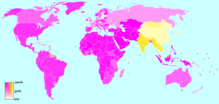ศาสนาแบบอินเดีย
ประชากรโลกที่นับถือศาสนาอินเดีย
ศาสนาแบบอินเดีย (อังกฤษ: Indian religions) หรือ ธรรมิกศาสนา (อังกฤษ: Dharmic religions) คือศาสนาที่มีต้นกำเนิดในอนุทวีปอินเดีย ได้แก่ ศาสนาฮินดู ศาสนาเชน ศาสนาพุทธ และศาสนาซิกข์[web 1] ศาสนาเหล่านี้ถือว่าเป็นศาสนาตะวันออก แม้ศาสนาแบบอินเดียจะเกี่ยวพันกับประวัติศาสตร์อินเดีย แต่ก็ไม่ได้มีอยู่เฉพาะในอนุทวีปอินเดียเท่านั้น ยังได้แพร่หลายไปยังภูมิภาคอื่น ๆ ด้วย[web 1]
ชาวฮารัปปาในอารยธรรมลุ่มแม่น้ำสินธุราว 3300-1300 ปีก่อนคริสต์ศักราชมีวัฒนธรรมแบบเมืองมาตั้งแต่ก่อนการเข้ามาของศาสนาพระเวท ชาวทราวิฑและตระกูลภาษาดราวิเดียนในอินเดียใต้ก็มีมาก่อนศาสนาพระเวทเช่นกัน
ประวัติศาสตร์นับจุดเริ่มต้นของศาสนาแบบอินเดียที่ศาสนาพราหมณ์ของชาวอินโด-อิหร่าน ซึ่งต่อมาได้รวบรวมคำสอนเป็นคัมภีร์พระเวท และเรียกยุคที่มีการเรียบเรียงคัมภีร์พระเวทว่ายุคพระเวท ซึ่งตรงกับช่วง 1750-550 ปีก่อนคริสต์ศักราช[1] จากนั้นจึงเป็นยุคปฏิรูป ซึ่งได้พัฒนาศาสนาพราหมณ์มาเป็นศาสนาฮินดูในปัจจุบัน[2] มีขบวนการสมณะเป็นขบวนการศาสนาที่เกิดขึ้นแยกจากสายพระเวทและดำรงอยู่คู่ขนานกันมา ศาสนาพุทธ[3] ศาสนาเชน[4] สำนักโยคะ[5] ความเชื่อเรื่องสังสารวัฏ และโมกษะ[6] ก็มีที่มาจากขบวนสมณะนี้ด้วย
ยุคปุราณะซึ่งตรงกับช่วง 200 ปีก่อนคริสต์ศักราชถึง ค.ศ. 500 และต้นยุคกลางซึ่งตรงกับ ค.ศ. 500-1,100 เป็นช่วงที่เกิดสำนักใหม่ ๆ ขึ้นในศาสนาฮินดู เช่น ขบวนการภักติ ลัทธิไศวะ ลัทธิศักติ ลัทธิไวษณพ จากนั้นจึงเข้าสู่ยุคอิสลามราว ค.ศ. 1,100-1,500 และคุรุนานักเทพตั้งศาสนาซิกข์ขึ้นในคริสต์ศตวรรษที่ 15[web 2] และแพร่หลายมากในภูมิภาคปัญจาบ
เมื่อถึงยุคที่จักรวรรดิอังกฤษเข้าปกครองอินเดีย กระแสการตีความศาสนาฮินดูใหม่เป็นตัวช่วยหนึ่งที่ทำให้เกิดกลุ่มเคลื่อนไหวเพื่อปลดปล่อยอินเดีย
ความเหมือนและความแตกต่าง

ตามแนวทางของ Tilak เราอาจศึกษาตีความศาสนาแบบอินเดียในส่วนของความเหมือนและความแตกต่าง[7] ผู้ศึกษาจากตะวันตกมักเน้นไปที่ความแตกต่าง ในขณะที่นักวิชาการอินเดียเองมุ่งเน้นศึกษาส่วนที่เหมือนกัน[8]
ความเหมือน
ศาสนาฮินดู ศาสนาพุทธ ศาสนาเชน และศาสนาซิกข์ มีหลักการพื้นฐานบางอย่างร่วมกัน ซึ่งอาจตีความต่างออกไปโดนศาสนิกชนแต่ละกลุ่มและแต่ละปัจเจกบุคคล[8] ก่อนคริสต์ศตวรรษที่ 19 ศาสนิกชนเหล่านี้มิได้ติดป้ายตนเองให้แตกต่างจากผู้อื่น หากแต่เห็นว่าตนเป็นส่วนหนึ่งของครอบครัวทางวัฒนธรรมที่แตกสาขาออกมาแต่ร่วมรากเดียวกัน[9]
ความต่าง
ศาสนาแบบอินเดียแต่ละศาสนามีความแตกต่างกัน และภายในแต่ละศาสนาก็มีความแตกต่างกันระหว่างนิกาย[10][11] เช่น ธรรม ในศาสนาฮินดูหมายถึง หน้าที่ ในศาสนาเชน หมายถึง การทำความดี ส่วนศาสนาพุทธเรียกว่า พระธรรม หมายถึง คำสอนของพระพุทธเจ้า
อ้างอิง
- ↑ Michaels 2004, p. 33.
- ↑ Michaels 2004, p. 38.
- ↑ Svarghese 2008, p. 259-60.
- ↑ Jain 2008, p. 210.
- ↑ Mallinson 2007, p. 17-8, 32-33.
- ↑ Flood 2003, p. 273-4.
- ↑ Sharma 2008, p. 239.
- ↑ 8.0 8.1 Sherma 2008, p. 239.
- ↑ Lipner 1998, p. 12.
- ↑ Larson 2012, p. 313-314.
- ↑ Yelle 2012, p. 338-339.
สิ่งพิมพ์
- Flood, Gavin; Olivelle, Patrick (2003), The Blackwell Companion to Hinduism, Malden: Blackwell
- Jain, Arun (2008), Faith & philosophy of Jainism
- Larson, Gerald James (2012), "The Issue of Not Being Different Enough: Some Reflections on Rajiv Malhotra's Being Different", International Journal of Hindu Studies (Vol. 16, No. 3, December 2012)
- Mallinson, James (2007), The Khecarīvidyā of Ādinātha
- Michaels, Axel (2004), Hinduism. Past and present, Princeton, New Jersey: Princeton University Press
- Sherma, Rita D.; Sarma, Aravinda (2008), Hermeneutics and Hindu Thought: Toward a Fusion of Horizons, Springer
- Svarghese, Alexander P. (2008), India : History, Religion, Vision And Contribution To The World
- Yelle, Robert A. (2012), "Comparative Religion as Cultural Combat: Occidentalism and Relativism in Rajiv Malhotra's Being Different", International Journal of Hindu Studies (Vol. 16, No. 3, December 2012)
แหล่งข้อมูลอื่น
- ↑ 1.0 1.1 Adams, C. J., Classification of religions: Geographical, Encyclopædia Britannica, 2007. Accessed: 15 July 2010
- ↑ Adherents.com. "Religions by adherents". คลังข้อมูลเก่าเก็บจากแหล่งเดิม (PHP)เมื่อ 2011-07-09. สืบค้นเมื่อ 2007-02-09.
แหล่งข้อมูลอื่น
- สถิติ
- "Census of India 2001: Data on religion". Government of India (Office of the Registrar General). สืบค้นเมื่อ 2007-05-28.
- กฎหมาย
- "Constitution of India". Government of India (Ministry of Law and Justice). สืบค้นเมื่อ 2007-05-28.
- รายงาน
- "International Religious Freedom Report 2006: India". United States Department of State. สืบค้นเมื่อ 2007-05-28.
Text is available under the CC BY-SA 4.0 license; additional terms may apply.
Images, videos and audio are available under their respective licenses.
